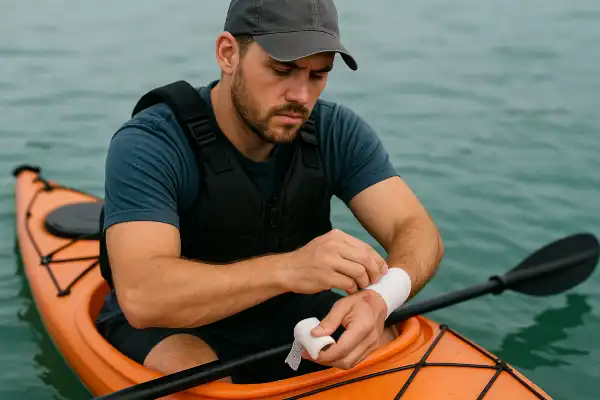How do you kayak camp safely when you’re miles from the nearest road, surrounded by water that could turn hostile without warning? This question surfaces in the minds of every paddler who’s felt the magnetic pull of a distant shoreline where no footprints mark the sand. The allure of sliding your kayak onto an untouched beach, setting up camp under a canopy of stars, and waking to the gentle lap of waves is undeniable.
During my instructor training years ago, I learned that confidence on the water comes not from fearlessness, but from thorough preparation. After guiding dozens of overnight expeditions—from the cypress-lined channels of the Everglades to the rocky coasts of Maine—I’ve seen how proper safety planning transforms anxious paddlers into confident adventurers who return home with stories instead of scars.
How do you kayak camp safely?
Kayak camping safely requires a layered approach to risk management that addresses the unique challenges of being both on water and in remote locations. The key is making wise choices that lean towards safety and security, especially when you’re far from civilization and dealing with bigger water.
Success comes from planning for three critical phases: getting to your campsite safely, maintaining security while camping, and ensuring a safe return journey. Each phase presents distinct risks that compound when you’re carrying camping gear and potentially traveling in challenging conditions.

Weather awareness and route planning
The best way to protect yourself from a thunderstorm is not to be in one! Know the forecast before heading out, especially if it’s a day trip and can be easily rescheduled. Check multiple weather sources before departure, including marine forecasts that provide wind speed, wave height, and visibility conditions.
Winds above 12-15 mph are considered unsafe for canoeing or kayaking on large bodies of water. Plan your route with bailout points—sheltered areas where you can wait out deteriorating conditions. When camping on islands or remote shores, always have an escape plan if weather turns dangerous overnight.
Study tide charts if paddling in tidal waters, as extreme low tides can strand you while high tides might flood your campsite. Share your detailed itinerary with someone reliable, including planned campsites and expected return time.
Proper gear selection and clothing
Dress for the water temperature, not the air temperature—a capsize and hypothermia can happen suddenly. This fundamental rule becomes critical when you’re hours from help. In 50°F water, the average person has a 50-50 chance of being able to swim 50 yards in full clothing due to rapid onset of hypothermia.
Wear your personal flotation device constantly while on the water. US Coast Guard data shows that for 80+% of kayaking fatalities, the deceased was not wearing a life jacket. Choose a PFD with multiple pockets for essential safety items like whistle, knife, and emergency signaling devices.
Layer clothing appropriately: moisture-wicking base layers, insulating middle layers, and waterproof outer shells. For cold-water paddling, consider a kayaking drysuit—a full-length jumpsuit with integrated seals at the wrist and neck. Pack dry clothes in waterproof bags as backup, since wet clothing dramatically accelerates heat loss.
Hypothermia prevention and water safety
When people fall into cold water (60-65°F or colder), the first involuntary reaction is a gasping reflex. If your head happens to be underwater when you involuntarily gasp, you may inhale water and drown. Understanding the 1-10-1 rule is crucial: you have 1 minute to stabilize breathing, 10 minutes of meaningful movement before cold water incapacitation, and 1 hour before hypothermia renders you unconscious.
The first rule for paddling in cold climates is: dress for the water temperature. Your route selection and clothing need to protect you from at least two of the three primary exposures: cold temperature, windy conditions, and wet insulation.
Practice self-rescue techniques in controlled conditions before your trip. Know how to perform a paddle float rescue, T-rescue with a partner, and wet exit if you use a spray skirt. These skills become life-saving when performed in rough conditions while wearing full camping gear.
Safe food storage and bear awareness
Bears learn quickly and will return to areas where they find food. Not only can this be dangerous for people, but it is also harmful to bears. Proper food storage protects both wildlife and campers.
Use bear-resistant containers when required by local regulations. Bear canisters fit in most expedition sea kayaks with 10-inch round or oval bow hatches and protect your food from spills of sticky, smelly food that could attract animals even when your food is out of the boat. In non-bear country, store food in scent-proof bags inside closed kayak hatches, then turn the kayak over.
Place bear containers on flat, level ground 100 feet or more from your campsite. Do NOT place containers near cliffs or any water source, as a bear may knock the container around trying to open it. Never store food, toiletries, or scented items in your tent.
Cook and eat away from your sleeping area. Try to wear different clothes for eating/cooking so that you can keep them away from your tent overnight. Clean dishes thoroughly and dispose of greywater at least 200 feet from water sources and campsites.
Water purification and hydration
No matter how clear and clean backcountry water looks, there’s no guarantee it’s safe for people to drink. Microorganisms in wilderness waters can cause an array of nasty consequences, from mild to severe.
Carry multiple water purification methods for redundancy. Water filters certified to remove bacteria, viruses, and parasites like giardia and cryptosporidium provide the most comprehensive protection. Water purification tablets containing chlorine dioxide handle more microorganisms than straight iodine but require 4 hours to work, so plan ahead.
Boiling water for at least one minute kills most pathogens and requires no special equipment beyond your camp stove. Pack extra water for cooking and emergency use, especially in areas where water sources might be contaminated or unavailable.
Emergency preparedness and communication
Pack a safety kit containing a whistle, mirror, flashlight, sunscreen, water, and a snack. Modern emergency communication devices like personal locator beacons (PLBs) or satellite messengers can summon help when cell coverage is nonexistent.
Use your whistle to attract attention: one blast means “Pay Attention,” two blows mean “Group meeting,” and three consecutive blasts mean “Emergency.” Establish these signals with your group before departure.
Carry a comprehensive first aid kit appropriate for your group size and trip duration. Include treatments for hypothermia, cuts, sprains, and medication for group members’ specific needs. Know how to use everything in your kit—wilderness first aid training is invaluable for remote camping.
Campsite selection and setup
Choose campsites that offer protection from wind and waves while maintaining access to your kayaks. Look for established sites when available to minimize environmental impact. Avoid camping directly on beaches where rising tides could flood your gear or wash away your kayaks.
Set up camp with weather changes in mind. Look around when you set up camp in the event a storm would roll through during the night. Have a plan for where to go for everyone in your group. Position tents away from widow-makers (dead tree branches) and in areas that won’t become wind tunnels.
Secure your kayaks above the high tide line and tie them down. Sudden weather changes can create waves that wash unsecured boats away, leaving you stranded. Store paddles and essential gear separately from your kayaks in case one gets damaged or lost.
Conclusion
Three months ago, I guided a family on their first kayak camping trip to a small island off the Georgia coast. The father admitted his nervousness about “all the things that could go wrong.” By the second morning, as we sat around our camp stove watching dolphins surface in the distance, he told me how our pre-trip safety briefing had transformed his anxiety into genuine confidence. Following established safety protocols doesn’t limit adventure—it amplifies it by giving you the skills and knowledge to push your boundaries responsibly. When you know you’re prepared for challenges, you’re free to fully embrace the profound peace that comes from sleeping under stars accessible only by paddle.
Follow Expobright for exclusive kayak and canoe camping tips.
